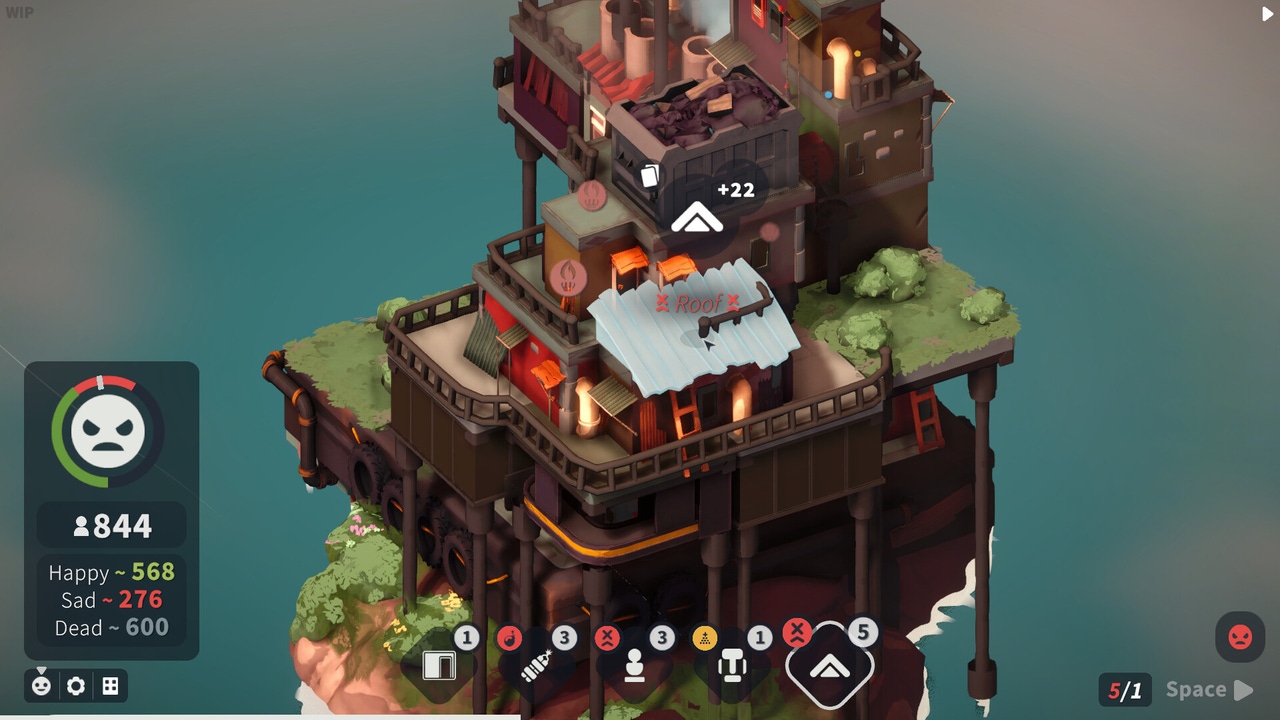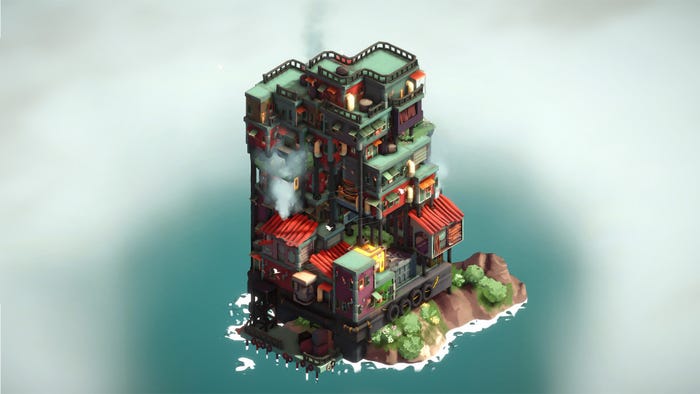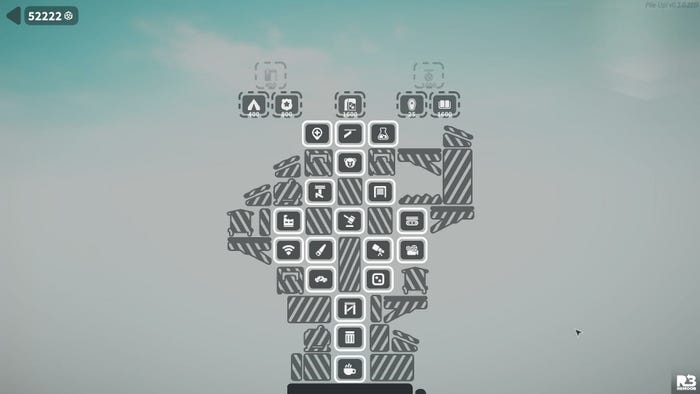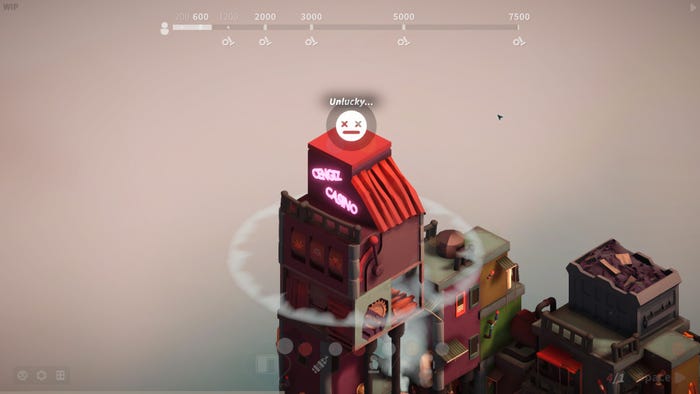Trending
Opinion: How will Project 2025 impact game developers?
The Heritage Foundation's manifesto for the possible next administration could do great harm to many, including large portions of the game development community.

Mustafa Kilic talks about some of the many challenges and creative solutions that came about from creating a city builder that builds upwards instead of outwards with Pile Up!

The IGF (Independent Games Festival) aims to encourage innovation in game development and to recognize independent game developers advancing the medium. Every year, Game Developer sits down with the finalists for the IGF ahead of GDC to explore the themes, design decisions, and tools behind each entry. Game Developer and GDC are sibling organizations under Informa Tech.
Pile Up! Is a city builder that constructs cities upwards instead of outwards, seeing players construct towering cities up into the sky. So long as you build carefully, that is.
Game Developer spoke with Mustafa Kiliç and Arda Karaköz of Remoob, the game’s developer, to learn more about the challenges that come from designing buildings meant to be placed on top of one another, how they created systems and locations that would inspire creativity from players in how they managed their cities, and
Who are you, and what was your role in developing Pile Up!?
Mustafa Kiliç, game designer: Hi! I’m Mustafa Kiliç and I’m the game designer of Pile Up!. I will be answering the questions on behalf of the team based on all of our answers.
What's your background in making games?
Kiliç: Just like everyone else in the team, I started making games in my junior year of high school while the pandemic was happening. People under 18 couldn’t go outside for safety purposes, so it was a great opportunity to improve. After a year or two spent learning the basics, we’ve participated in lots of game jams to improve our development skills and team coordination. Also, this was one of the things that gave us a huge motivation to continue since we placed first at one of the biggest game jams organized in Turkey called “Mağara Game Jam'' at that time. It feels wild how it’s been nearly four years since we started working on games.

Images via Catoptric Games and IndieArk
How did you come up with the concept for Pile Up!?
Kiliç: We were in a game development event which our current publisher, Catoptric Games, was organizing. The main focus of the event was to develop a game for Steam in a week and the main theme was "Freedom." So, with this in mind, our developer Arda Karaköz talked about a movie he watched called Rose Island in which an Italian engineer gets sick of the rules limiting his engineering dreams. So, he builds a new island from metal just outside the country’s maritime boundaries so he can start his own country. After Arda talked about the movie and we watched it, we wanted to make a city building game out of this idea.
What development tools were used to build your game?
Kiliç: We used Unity as the game engine, Fmod for sound implementation, Adobe Photoshop and Illustrator for drawings, Blender for models, Substance Painter for the textures and materials, Reaper for sound effects, FL Studio for music, and basically any versatile note app we could find to keep the documentation.
Pile Up! is a city builder about building up, not out, creating steadily more unstable cities that reach up into the sky. What appealed to you about creating a city builder where the city keeps getting taller?
Kiliç: After we started making the game, we realized that we had to think about where the buildings would be placed. We thought about making the island bigger as the game progressed or allowing the buildings to be placed on top of each other. Since the theme was freedom, we thought stacking the buildings would be a better fit since you could also build vertically. It was not a common mechanic between city builders and was giving a fresh take on freedom.
Where most city builders are limited by the space of building outwards, building upwards would require its own kind of limitations. How did you create a space limitation around verticality? What thoughts went into creating this limitation, as well as how you would communicate it to the player?
Kiliç: So, the main problem with a vertical building city is that... you can’t think about anything in two dimensions.
At first, we wanted the game to have realistic physics. But after our game tests, we realized that most of the time players couldn’t realize when their city would collapse just until it collapsed; there were no visual indicators and physics was limiting. Since it was also in conflict with the “Freedom” theme, we scrapped that idea which lead into the game becoming this interesting city builder where every building can be held up by even the thinnest columns.
The camera was the biggest problem throughout the game’s development. In most city builders, you can see your camera moving mostly in two axes. While some of these games don't even have vertical movement, the others usually don’t make the control as easy to access since the games don't really need them. But in Pile Up!, the player has to use vertical movement all of the time which means that the player has to have access to controls for all of the axes.
This was such a challenging job since the player also has other button-based interactions with their city and every motion should happen swiftly. Even if we added all the axis controls, if they weren’t fluid enough it would be a problem. Nobody would like to do more than two inputs just to reach the place they want to put just one building. This was the same reason why we didn’t go with a free camera; you had to put more effort into controlling the camera than placing buildings just to keep playing the game. Also; the game was orthographic, so we couldn’t let players have a peek from all angles. This was changed afterwards while we updated the camera system to improve camera and visuals though.
Another problem was the shapes of the buildings. Roofs of the buildings need to be flat so people can keep building on top. But we knew that that would result in losing uniqueness on most of the buildings’ silhouettes. So, we had to try different models and ideas to make the buildings unique while still having a flat top. Also, buildings were getting buried between other ones as the player kept placing new buildings. This is why we’ve added supports and tried different building shapes in the game while keeping houses'—the main buildings—shapes basic to keep the cities look unified and tried to get rid of the negative over-time effects since the player couldn’t see where that effect was coming from.

Images via Catoptric Games and IndieArk
You mention that the buildings in the game have been inspired by card games. Can you tell us more about how that came to be, and the ideas that went into the kinds of buildings players can work with?
Kiliç: Most card games work around an archetype system. An archetype is a group of cards that work really well with each other while still maintaining a connection between different archetypes. We wanted to add this coherent system into Pile Up!’s building system which consists of seven different building types.
Basic types in Pile Up! are what make the foundation of the game. Factories give the players buildings, houses are the main resource of population, requirement buildings are needed to keep citizens happy and supports can be attached to other buildings to increase the area. But the more complex types are where we adapted the archetype system.
Action buildings are the unique buildings with effects in Pile Up!, but not all of their effects are beneficial for the player. These are all about the situation and how the player uses them. A badly placed action can be really problematic while a well-placed one can help the player in lots of different ways. Special buildings, however, are all about helping the player. But since special buildings are pretty rare and they can either improve an action building's advantages or limit its problems, the player needs to choose very carefully.
The archetype system works with special and action buildings. While designing the buildings, I focus on designing a couple of special and action buildings which serve the same purpose in different ways. For example, an archetype in the game just focuses on luck. One of the special buildings (called Dump) lets the player pass the round even though the player still has some buildings that they haven’t placed in that turn. So, these buildings from the same archetype work really well with each other, all while working with other archetypes. You can always select the Dump if you have some buildings you don’t want to use.
How would a good builder make use of some of these combinations?
Kiliç: Some mechanics in the game are turn-based while others need specific buildings to thrive. So, a great builder who knows about the game’s core and most of the buildings’ mechanics can try different building combinations to maximize the population they can get, decrease any risks, keep their people happy for all times. or achieve more as long as they make their selections correctly and play their buildings at the right order on the right places.
You mention elements of randomness add some surprising challenges to each build. How did you design these random elements, and what appealed to you about adding them in?
Kiliç: In Pile Up! we wanted to make every city and playthrough different from each other while still preserving the balance and experience. So, we designed a randomness system which still lets us have control over it.
The RNG consists of two layers in Pile Up!. The first layer is where the selection happens in the game. Whenever the player reaches a certain milestone—a specific count of population—a selection for special buildings pops up. At that point of the game, the player can choose a building out of a fixed count of random buildings. Like most games, we wanted to keep this important phase of the game as simple as possible.
Action factory selection, however, is different. Action buildings come from action factories which the player gets to select on certain milestones like special buildings. But since these are factories rather than a singular building, and include multiple different buildings inside them, the count of options, how many different buildings an option should have, and how many total buildings an option should give can be all randomized individually. This complements the design of building interactions since the player can either get favorable buildings or buildings that might cause problems for their city. This keeps the challenge going throughout the game.
The second layer is the factories. Houses, requirements, supports, and action buildings all come from their related factory in Pile Up!. Each factory has a fixed pool, but the order of buildings given are always random. So, other than action buildings—which still are the same amount—everyone at every run gets the same buildings in a different order.
But what is quite interesting is that since the clarity over this system is still not as great as we would like, most of the players think factories give totally random buildings each run. Therefore sabotaging their gameplay. So, we are working on preventing this issue while improving the replayability with more content.
What ideas went into the design of the islands? How did you create landscapes that would encourage building creativity?
Kiliç: We focus on two main things while designing the islands: What is the unique aspect of this island and how will this island look like? The unique aspect is usually focused on the game's mechanics and how to use them in a different way. For example, the first island, Rectland, is quite a simple island with a square shape so the players can learn the game in a basic playground, while the third island, Noland, doesn’t have any land to place the buildings on as the name suggests. So, the players start with a couple of support buildings to attach to a huge column in the middle so they have some place for buildings.
The same concept applies to visuals as well. While Rectland has a basic metal/concrete visual to it, Noland is literally above the clouds. The only thing you see while starting on Noland is a powerful beam of light and a couple of columns. So, color schemes also change accordingly too. We try to create a fresh atmosphere for each island.

Images via Catoptric Games and IndieArk
What thoughts went into the visual design of the buildings? How did you add beauty to the cities players could build through your building design?
Arda Karaköz, developer and technical artist: Initially, we wanted to utilize the "vertical" aspect of city builders with an atmospheric scrap city theme, so we shaped our visual decisions around this vision. We wanted to make every placement feel satisfying and exact, which resulted in a more cubic kind-of building designs with squash-and-stretch based animations. Through the development phase, we also added a prop placement system and railings to make buildings look more interconnected and reactive. Even though some people think Pile Up! benefits from advanced procedural generation, it is mostly a matter of smoke and mirrors. And I think that is where its beauty lies.
Likewise, what thoughts went into the visual effects that occur when plopping them down? How do you make it look satisfying to simply put a building down or select an element from a menu?
Karaköz: Throughout the development process, we experimented with various styles for VFXs and animations. In the end, we decided on a style primarily based on the squash-and-stretch approach. We believed this choice would provide a more satisfying experience, especially when achieving a perfect placement. The most important thing about the VFXs was making them look compatible with the semi-stylized art style of Pile Up!. With that direction, we tried to stick to our design rules and generic shaders as much as possible. As for the buildings, most of the tweening animations and squash-and-stretch effects follow similar easings according to their function. For Pile Up! we've mostly used an OutCubic easing for animations and effects. On top of that, we've used a texturing technique called SDFs (Signed Distance Fields) for the smooth blending of UI elements.
Another critical point was the re-usage of VFX assets. It was an important efficiency factor since we didn't have an infinite budget or time. Reusing the similar meshes, textures, curves provided us with compatible looking and satisfying effects until the end.
What drew you to add a sandbox mode to the game? What interested you in letting players freely build however they like in this mode?
Kiliç: At the start of development, the game was a basic sandbox experience focused on freedom and it was quite fun, so we wanted to preserve the mod and keep it for the release too. The only thing we added to the mod is a setting to disable building interactions for those who want to just build cities based on the visuals.
Players can discover memoirs during their builds. How did you work this story element into the game without interrupting the building? What made these stories feel important to include?
Kiliç: Memoir system is one of the mission systems of Pile Up!. Each building has two missions: one being a basic mission just to help players progress and unlock a tactic for that building while the other one being a more challenging and rewarding mission focused on helping players learn about the full capacity of buildings. The player also unlocks a memoir by completing this mission. A little part of the game’s lore.
We wanted the player to learn more about the story while figuring out the gameplay. The book was a good way to achieve this since we could write this information like an old engineer who wants to leave a mark for the future. But please keep in mind that the memoirs are still in development for us to improve the system and will be added with the next major update.
You May Also Like